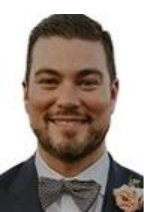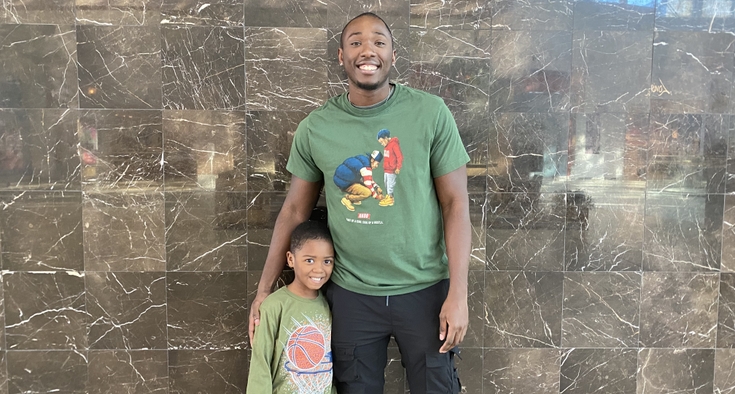Kathi Heslin, 72, and her family gather for dinner every Sunday evening. It’s a tradition that her grandmother and mother started, and now she and her sister, Vicki Young, honor them by carrying it on, taking turns cooking for their families.
Heslin and her husband of 49 years, Richard, describe the dinners as filled with lots of playful and sarcastic humor with their daughter, Megan, and loads of good food, like a Cool Whip, cream cheese and fruit confection Heslin calls a banana split.
Dinner on the spring evening of March 24 started out like many others, then Heslin’s life changed in an instant.
“We started cleaning up and the room went like this, up 90 degrees,” she said, gesturing with her hand.
Richard noticed Heslin was slurring her words and asked, “Are you feeling OK?” Heslin replied that she felt dizzy.
This was all it took for Heslin’s brother-in-law, Bob Young, to spring into action. Because of his quick thinking, Heslin is alive and healthy today, after her care team at Novant Health New Hanover Regional Medical Center in Wilmington removed the blood clot from her brain that was causing an ischemic stroke.
Award-winning stroke care.
BE FAST
Young recognized Heslin was experiencing two warning signs of stroke, dizziness and slurred speech, and immediately called 911. Moments later, the ambulance arrived.
Young is more than just a little bit accustomed to responding quickly and calmly in emergency situations. He’s been a volunteer in New Hanover Regional Medical Center’s emergency department for nine years. Plus, he’s a retired emergency medical technician (EMT) and volunteer firefighter. So, he’s seen plenty of strokes and knows that every second counts when blood flow is blocked to the brain.
Strokes are the No. 2 cause of death worldwide, and the leading cause of disability, the American Stroke Association reports. Each year, about 795,000 people in the U.S. have a stroke. Ischemic strokes, caused by a blood clot, make up about 87% of strokes, while hemorrhagic strokes, caused by a ruptured blood vessel, make up the rest.
What Young used to spot the signs of stroke is an acronym called BE FAST:
Balance – dizziness or loss of balance
Eyes – double vision or loss of vision
Face – facial asymmetry, like drooping, or numbness on one side of the face
Arms – one is weaker than the other
Speech – speech is slurred or the person may not be able to speak at all
Time – immediately call 911, don’t waitLess than 7 minutes to remove the clot
During the ambulance ride, the stroke team at New Hanover Regional Medical Center was getting ready for her to roll through the doors. The Wilmington hospital is one of three Novant Health comprehensive stroke centers, certified for having an elite medical staff and superior stroke units.

Once she arrived, Heslin was hurried to the angiography suite inside the Novant Health Neurosciences Institute. There, neurological surgeon Dr. Justin Cappuzzo used a minimally invasive technique called a thrombectomy to remove the clot from her brain. The technique uses X-ray and requires no open-brain surgery.
With a needle, Cappuzzo entered Heslin’s radial artery in her right arm, then placed a sheath, a thin plastic device to hold the artery open. He used a catheter to travel through the artery into the blood vessels in the brain. Once the catheter was in place, he used it to suck the blood clot out of Heslin’s middle cerebral artery in her brain. The procedure took less than seven minutes.
A complete recovery
The following day when Heslin awoke in the intensive care unit, she had little memory of being in the ambulance and no memory of what followed. She was stunned to learn she had suffered a stroke. But her care team helped ease her anxiety.
“I had the nicest, most compassionate people – nurses, aides and doctors,” she said. “It was just amazing. I just can't say enough good about them.”
As she absorbed the details of what happened, Heslin was grateful, but not surprised, to learn that Young had calmly taken charge of the situation and known exactly what to do.
“I'm blessed beyond measure, and I would not expect any other reaction from him,” she said.
Cappuzzo emphasized that Young’s quick action helped ensure Heslin’s positive outcome and full recovery.
“Timing is extremely important,” he said. “We know people do better if they get medical help sooner.”
Also integral to the equation is the technology that’s used once the stroke victim is in the hands of a care team. Cappuzzo explained the New Hanover team uses state-of-the-art imaging called CT perfusion, a noninvasive procedure that provides a detailed color map of blood flow to the brain. This allows doctors to identify parts that can be saved, and parts that have already been impacted by stroke.
“Sometimes we can do this days from the onset of symptoms, depending on the patient,” Cappuzzo said. In other words, don’t skip going to the hospital for stroke care if you didn’t go the moment you began experiencing symptoms. It’s better to go late than never.
‘A second chance’
A few months after her stroke, Heslin is back to spending time with her family and experiencing no residual effects. They continue to dine together on Sundays – although Heslin says she’s working on making some lifestyle changes, like fewer banana splits and more vegetables.
“I feel like I've been given a second chance to do good, and I take that very seriously,” she said.

And as for Young, on May 17, he was awarded the prestigious President’s Volunteer Service Award for clocking more than 4,000 volunteer hours at the hospital. During a celebration with other awardees and several Novant Health hospital leaders, he accepted a certificate signed by President Joe Biden.
While Heslin said she’s known for a long time that Young is a wonderful volunteer, friend and relative, something new she learned from the experience is how important it is for everyone to know the signs of a stroke so that they can help save a life, like he did.













